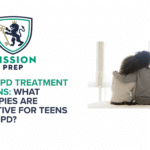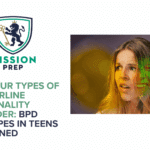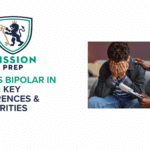What Is Borderline Personality Disorder (BPD)?: Symptoms and Emergency Support


Borderline Personality Disorder (BPD) often begins in adolescence, but it’s frequently misunderstood or misdiagnosed. Research shows that up to 3% of adolescents may meet the criteria for BPD, yet many teens don’t get appropriate support until symptoms have deeply impacted their daily lives¹.
This lack of support may be partly because the early signs of BPD in youth, like emotional intensity, impulsive behavior, and shifting identity, can resemble “normal” mood swings.
But when emotional dysregulation in teens becomes overwhelming and ongoing, it may point to something deeper. Understanding borderline personality disorder in teens can be the first step toward healing. With the right diagnosis, education, and therapy options for BPD teens, long-term outcomes can improve dramatically.
If you’re concerned about BPD in a teen, health professionals are always on hand to provide assistance. This guide can also help by exploring the following aspects of borderline personality disorder in teens:
- What BPD is in youth
- Signs of BPD in adolescence
- Therapy options for BPD teens
- BPD vs bipolar teens – similarities and differences
- How Mission Prep can help educate parents of BPD teens and help BPD teens
What Is BPD in Youth?
Borderline Personality Disorder (BPD) in teens is a complex mental health condition that affects how young people feel, think, and relate to others. At its core, BPD involves emotional instability, identity confusion, and difficulty managing relationships, all of which can be especially intense during adolescence.²
Many parents wonder if they’re overreacting when they start to notice their teen’s mood swings and emotional dysregulation ramp up. While emotional ups and downs can be typical teen behavior, BPD has more extreme symptoms that last longer and can be disruptive to daily life.
For instance, even a minor disagreement can trigger a deep sense of abandonment in a BPD teen.³ This trigger could be changed plans or a friend not texting back promptly. Some may assume that these reactions are exaggerations. However, they come from a dysregulated nervous system and a mind that doesn’t have a firm grip on who they are.
Youth identity actually plays a key role in BPD. Teens with borderline personality disorder often struggle with a stable sense of self, which can lead to impulsive behaviors, chronic emptiness, and self-harm.⁴
Signs of BPD in Adolescence
Spotting borderline personality disorder in teens can be tricky. Teens with BPD often experience emotional dysregulation that goes beyond everyday stress. For instance, if your teen seems overwhelmed by feelings they can’t name or manage, or if their relationships feel like a rollercoaster, it’s worth paying attention.
Common signs of BPD in adolescence include:
- Sudden, intense mood swings that may last hours to days – not just fleeting frustration or sadness⁵
- Extreme fear of abandonment, including frantic efforts to avoid real or imagined rejection⁴
- Unstable or chaotic relationships, often flipping between idealizing and devaluing others⁶
- Identity confusion, including rapid shifts in self-image, values, or goals (hallmarks of youth identity confusion)
- Chronic feelings of emptiness or worthlessness that don’t improve with reassurance⁷
- Impulsive behaviors that may include risky sex, reckless driving, or binge eating⁸
- Self-harming behaviors like cutting, burning, or suicidal threats – even if they’re not intended to cause death. Studies show that 50% to 80% of cases include self-harm⁹
- Difficulty trusting others, even close friends or family, due to intense sensitivity or past betrayal¹⁰
- Explosive anger or irritability, often disproportionate to the situation¹¹
- Brief episodes of dissociation or feeling detached from reality, especially during stress¹²
It’s important to remember that no single symptom confirms a teenage BPD diagnosis. But when several of these signs cluster together and persist over time, a deeper evaluation can help uncover what’s really going on.
Early signs of BPD in youth often emerge in early childhood and adolescence. This is why understanding the difference between everyday emotional intensity and more serious patterns of emotional instability in teens is crucial. The earlier borderline personality disorder in teens is identified, the better the chances of effective intervention and healing.
Therapy Options for BPD Teens
Borderline personality disorder in teens can feel overwhelming for both teens and their caregivers. Yet, with the right kind of support, healing is not only possible, it’s likely. Today, therapy options for BPD teens are more effective and accessible than ever, especially when care is tailored to the teen.
At Mission Prep, we take an integrative, trauma-informed approach to treating borderline personality disorder in teens. This means we look at the full picture, including the teen’s past experiences, current struggles, identity development, relationships, and nervous system health.
Core approaches recommended for adolescent borderline traits include the following sections.
Dialectical Behavior Therapy (DBT)-Informed Support
Attachment-Based Therapy
Many teens with BPD symptoms struggle with insecure or disrupted attachment that stems from early life experiences.14 Therapists can help rebuild trust, emotional safety, and connection – key components for regulating emotions and improving relationships. Attachment-focused therapy also supports youth identity confusion by helping teens explore who they are in safe, connected ways.
Somatic and Mind-Body Techniques
Emotional dysregulation in teens often shows up physically as racing hearts, clenched jaws, or a sense of being overwhelmed. Body-based interventions can help teens notice and work with these sensations, promoting nervous system stability. For teens who feel too overwhelmed to talk, these approaches offer a gentle, effective starting point.
Trauma-Informed and Developmentally Sensitive Care
BPD and self-harm in teens often reflect past emotional injuries.15 Mission Prep works slowly and respectfully, never pushing a teen to open up before they’re ready. Instead, we co-create a sense of safety and predictability that allows deeper healing to unfold over time. Therapy for teens with BPD is about understanding, compassion, and a plan that works.
Family Support and Psychoeducation
Parents and caregivers are part of the BPD healing process. We offer BPD education for parents so they can better understand emotional instability in teens, reduce conflict, and become partners in healing. When families learn how to respond instead of react to borderline traits, the entire system begins to shift.
Whether your teen is newly exploring what BPD in youth might mean for them or has already received a teenage BPD diagnosis, the most important step is finding the right support. Treatment should focus on their dignity, safety, and long-term growth. Help for teens with BPD isn’t one-size-fits-all, but it is out there, and it works.
BPD vs Bipolar Teens
Because both conditions involve mood changes and emotional intensity, borderline personality disorder and bipolar disorder are often confused, especially in adolescence. But while they may look similar on the surface, they are fundamentally different in how they develop, show up, and respond to treatment. Also, it’s good to note that BPD and bipolar in teens can coexist.16
Bipolar disorder in teens is primarily a mood disorder. It involves cycles of depression and mania or hypomania, which are periods of unusually high energy, impulsivity, or euphoria.¹⁸ These episodes tend to last for days or weeks at a time and often come with noticeable shifts in sleep, speech, or behavior. Between episodes, many teens with bipolar disorder can return to a more stable baseline.
Borderline personality disorder in teens, on the other hand, is a personality disorder rooted in emotional dysregulation, unstable self-image, and interpersonal sensitivity. Rather than long mood episodes, teens with BPD often experience rapid mood shifts in response to relationships or perceived rejection. For example, a friend not texting back might trigger feelings of abandonment or worthlessness. These changes can happen within hours or even minutes.
Other key differences in BPD vs bipolar teens:
- BPD is more reactive to relationship dynamics, while bipolar is more cyclical and internally driven18
- Teens with BPD often struggle with identity confusion and chronic emptiness, which are not typical in bipolar disorder
- Self-harm and fear of abandonment are hallmark traits in adolescent borderline presentations, but are not diagnostic features of bipolar disorder
Understanding the distinction between BPD vs bipolar in teens is essential because misdiagnosis can delay the right kind of care. That’s why professional evaluation and compassionate, trauma-informed interpretation of symptoms matter.

Reach Out to Mission Prep for BPD Education for Parents and Help with BPD Teens
Borderline personality disorder can be overwhelming for teens and families trying to support them.
At Mission Prep, we provide both therapy options for BPD teens and clear, accessible BPD education for parents. Our goal is to help families understand what emotional dysregulation in teens really means, and how identity confusion or rapid emotional shifts aren’t signs of manipulation, but of distress.
Whether your teen has a formal diagnosis or you’re beginning to notice early signs of BPD in youth, we’re here to help. Our clinicians use trauma-informed, evidence-based methods to build safety, increase emotional regulation, and strengthen healthy identity development in adolescents.
If your family is looking for support, connection, or simply a place to begin, Mission Prep can guide you in creating a path forward. Contact us today to find out how we can help your teen feel seen, safe, and empowered.
References
- Guilé, J. M., Boissel, L., Alaux-Cantin, S., & de La Rivière, S. G. (2018). Borderline personality disorder in adolescents: Prevalence, diagnosis, and treatment strategies. Adolescent Health, Medicine and Therapeutics, 9, 199–210. https://pmc.ncbi.nlm.nih.gov/articles/PMC6257363/
- Chapman, J., Jamil, R. T., Fleisher, C., & Torrico, T. J. (2025). Borderline personality disorder. In StatPearls. StatPearls Publishing. https://www.ncbi.nlm.nih.gov/books/NBK430883/
- Uzar, M., Dmitrzak-Węglarz, M., & Słopień, A. (2023). Mentalizing in adolescents with borderline personality disorder. Brain Sciences, 13(10), Article 1473. https://pmc.ncbi.nlm.nih.gov/articles/PMC10605837/
- Leichsenring, F., Fonagy, P., Heim, N., Kernberg, O. F., Leweke, F., Luyten, P., Salzer, S., Spitzer, C., & Steinert, C. (2024). Borderline personality disorder: A comprehensive review of diagnosis and clinical presentation, etiology, treatment, and current controversies. World Psychiatry, 23(1), 4–25. https://pmc.ncbi.nlm.nih.gov/articles/PMC10786009/
- National Institute of Mental Health (NIMH). Borderline personality disorder. Retrieved July 14, 2025, from https://www.nimh.nih.gov/health/publications/borderline-personality-disorder
- Jeong, H., Jin, M. J., & Hyun, M. H. (2022). Understanding a mutually destructive relationship between individuals with borderline personality disorder and their favorite person. Psychiatry Investigation, 19(12), 1069–1077. https://pmc.ncbi.nlm.nih.gov/articles/PMC9806505/
- Miller, C. E., Townsend, M. L., Day, N. J. S., & Grenyer, B. F. S. (2020). Measuring the shadows: A systematic review of chronic emptiness in borderline personality disorder. PLOS ONE, 15(7), e0233970. https://pmc.ncbi.nlm.nih.gov/articles/PMC7329066/
- Svaldi, J., Philipsen, A., & Matthies, S. (2012). Risky decision-making in borderline personality disorder. Psychiatry Research, 197(1–2), 112–118. https://www.sciencedirect.com/science/article/abs/pii/S0165178112000327
- Oumaya, M., Friedman, S., Pham, A., Abou Abdallah, T., Guelfi, J.-D., & Rouillon, F. (2008). Personnalité borderline, automutilations et suicide: Revue de la littérature. L’Encephale, 34(5), 452–458. https://pubmed.ncbi.nlm.nih.gov/19068333/#:~:text=This%20pattern%20of%20behaviour%20is,or%20biting%20are%20not%20unusual
- Fertuck, E. A., & Preti, E. (2023). Interpersonal trust and borderline personality disorder: Insights from clinical practice and research: Introduction. Journal of Personality Disorders, 37(5), 469–474. https://pubmed.ncbi.nlm.nih.gov/37903021/
- Neukel, C., Bullenkamp, R., Moessner, M., Spiess, K., Schmahl, C., Bertsch, K., & Herpertz, S. C. (2022). Anger instability and aggression in borderline personality disorder: An ecological momentary assessment study. Borderline Personality Disorder and Emotion Dysregulation, 9, Article 29. https://pmc.ncbi.nlm.nih.gov/articles/PMC9575226/
- Al-Shamali, H. F., Winkler, O., Talarico, F., Greenshaw, A. J., Forner, C., Zhang, Y., Vermetten, E., & Burback, L. (2022). A systematic scoping review of dissociation in borderline personality disorder and implications for research and clinical practice: Exploring the fog. The Australian and New Zealand Journal of Psychiatry, 56(10), 1252–1264. https://pmc.ncbi.nlm.nih.gov/articles/PMC9511244/
- May, J. M., Richardi, T. M., & Barth, K. S. (2016). Dialectical behavior therapy as treatment for borderline personality disorder. The Mental Health Clinician, 6(2), 62–67. https://pmc.ncbi.nlm.nih.gov/articles/PMC6007584/
- Bozzatello, P., Rocca, P., Baldassarri, L., Bosia, M., & Bellino, S. (2021). The role of trauma in early onset borderline personality disorder: A biopsychosocial perspective. Frontiers in Psychiatry, 12, 721361. https://pmc.ncbi.nlm.nih.gov/articles/PMC8495240/
- McFetridge, M. A., Milner, R., Gavin, V., & Levita, L. (2015). Borderline personality disorder: Patterns of self-harm, reported childhood trauma and clinical outcome. BJPsych Open, 1(1), 18–20. https://pmc.ncbi.nlm.nih.gov/articles/PMC4995580/
- Durdurak, B. B., Altaweel, N., Upthegrove, R., & Marwaha, S. (2022). Understanding the development of bipolar disorder and borderline personality disorder in young people: A meta-review of systematic reviews. Psychological Medicine, 52(16), 1–14. https://pmc.ncbi.nlm.nih.gov/articles/PMC9816307/
- Jain, A., & Mitra, P. (2025). Bipolar disorder. In StatPearls. StatPearls Publishing. https://www.ncbi.nlm.nih.gov/books/NBK558998/
- Sanches, M. (2019). The limits between bipolar disorder and borderline personality disorder: A review of the evidence. Diseases, 7(3), 49. https://pmc.ncbi.nlm.nih.gov/articles/PMC6787615/



















